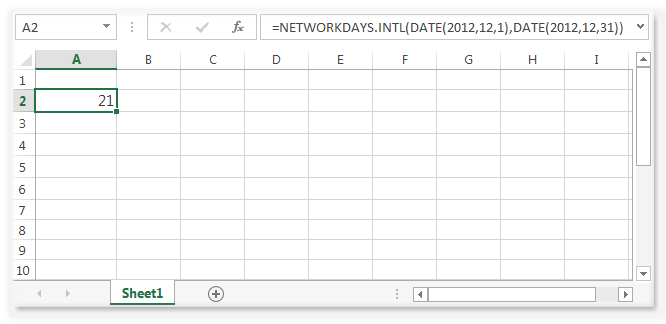Excel NETWORKDAYS.INTL() function
NETWORKDAYS.INTL() function
This function is used to return the number of whole workdays between two dates using parameters to indicate which and how many days are weekend days. Weekend days and any days that are specified as holidays are not considered as workdays.
Version: Excel 2013
Syntax:
NETWORKDAYS.INTL(start_date, end_date, [weekend], [holidays])
Parameters:
| Name | Description | Data Type | Required/ Optional |
|---|---|---|---|
| Start_date and end_date | The dates for which the difference is to be computed. The start_date can be earlier than, the same as, or later than the end_date. | Date | Required |
| Weekend | Indicates the days of the week that are weekend days and are not included in the number of whole working days between start_date and end_date. A Weekend is a weekend number or string that specifies when weekends occur. | Number,String | Optional |
| Holidays | A set of one or more dates that are to be excluded from the working day calendar. Holidays can be a range of cells that contain the dates, or an array constant of the serial values that represent those dates. | Date | Optional |
Here in the table shows that the weekend number values indicate the weekend days:
| Weekend number | Weekend days |
|---|---|
| 1 or omitted | Saturday, Sunday |
| 2 | Sunday, Monday |
| 3 | Monday, Tuesday |
| 4 | Tuesday, Wednesday |
| 5 | Wednesday, Thursday |
| 6 | Thursday, Friday |
| 7 | Friday, Saturday |
| 11 | Sunday only |
| 12 | Monday only |
| 13 | Tuesday only |
| 14 | Wednesday only |
| 15 | Thursday only |
| 16 | Friday only |
| 17 | Saturday only |
The weekend string values are seven characters long and each character represents a day of the week, starting on Monday. 1 represents a non-workday and 0 represents a workday. Only the characters 1 and 0 are permitted in the string. Using 1111111 will always return 0. For example, 0011000 would result in a weekend that is Wednesday and Thursday.
Remarks
- When start_date is later than end_date, the return value will be negative, and the magnitude will be the number of whole workdays.
- When start_date is out of range for the current date base value, NETWORKDAYS.INTL returns the #NUM! error value.
- When end_date is out of range for the current date base value, NETWORKDAYS.INTL returns the #NUM! error value.
- When a weekend string is of invalid length or contains invalid characters, NETWORKDAYS.INTL returns the #VALUE! error value.
Example - 1:
The example below calculate that, 22 future workdays is available in December 2012. Here in this example subtracts 10 nonworking weekend days (5 Saturdays and 5 Sundays) from the 31 total days between the two dates. By default, Saturday and Sunday are considered non-working days.

Example - 2:
The example below shows the results in -21, which is 21 workdays in the past.

Example - 3:
The example below returns the results in 22 future workdays by subtracting 10 nonworking days (4 Wednesday, 4 Thursday, 2 Holidays) from the 31 days between Dec 1, 2012, and Dec 31, 2012. Uses the 5 argument for the weekend, which is Wednesday and Thursday. There are also two holidays in this time period.

Example - 4:
The example below returns the result in 21 future workdays by subtracting 10 nonworking days. In this example below, the Tuesday and Friday are the weekend days, so in this time period there are 4 Tuesday and 4 Friday and also there are tow holidays as mention in the argument.

Previous: Excel NETWORKDAYS() function
Next:
Excel NOW ()function
